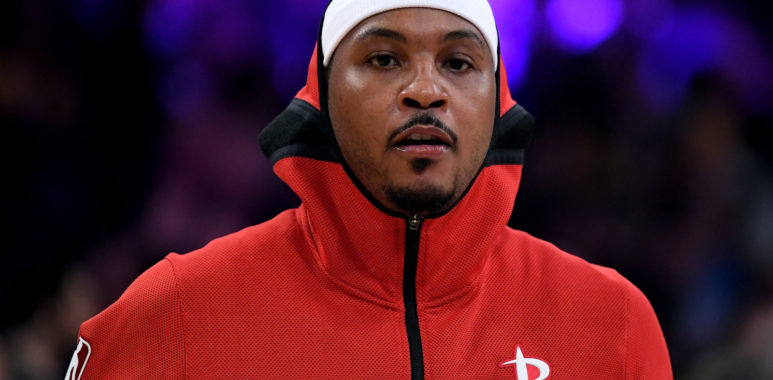
Carmelo Anthony isn’t THE problem, but he’s a big part of it
The Houston Rockets currently sit at 1-4. There are plenty of reasons for that, all of which vary in terms of responsibility.
There’s the lack of bodies; James Harden, James Ennis, and the corpse of Nene have all missed time to injury. Chris Paul missed a pair of games due to a suspension. Having 60 percent of your starting lineup (and Nene, I guess) miss time obviously isn’t ideal this early into the season.
In addition to that, the schedule has been tough. Their four losses have come via the Pelicans, Jazz, and Clippers (twice). At bare minimum, all three teams will be fighting for a playoff spot, though many hold the Jazz and Pelicans in higher regard.
The biggest issue has been the defense, which, as I wrote about here, has been a complete mess. As it stands now, Houston’s 114.7 defensive rating is nine points higher than it was last year. The personnel itself is worse than last year’s, but it shouldn’t be this much worse statistically, even with the small sample size.
Normally, this would be something to write off. And in a way, it still may be. We’re a couple of weeks into the season, for crying out loud. But head coach Mike D’Antoni clearly doesn’t see this as just randomness; he’s already talking about making some changes:
Sounds as if the Rockets will move away from switching as frequently as they did last season, they just lack the personnel. Coach D’Antoni said over the next two days they’ll “take some stuff out” from their current defensive scheme.
— Kelly Iko (@KellyIkoNBA) October 27, 2018
Yikes.
Though the supporting cast as a whole has been questionable, one player has stood out: future Hall-of-Fame forward Carmelo Anthony.
Anthony has never been confused for an elite defender, and it’s hard to imagine that anyone expected him to be a plus on that end this year. Still, the early returns have been quite ugly.
The Melo Problem
The Rockets have posted a defensive rating of 116.1 with Anthony on the floor this season. That number drops to 105.3 with Anthony on the bench. Obviously that isn’t all his fault, but it’s noteworthy that he has the largest differential in defensive rating among the rotation players. The only guy on the roster that with a larger negative swing is rookie Gary Clark.
Anthony’s defensive woes don’t come down to effort. He’s done his best in Houston’s switch-heavy scheme. He tries to move his feet and keep his head on a swivel. Ultimately, he just can’t survive; at the very least, he hasn’t done so this season.
In a vacuum, Anthony is everything mid-2000s general managers hated about “tweener” forwards. He doesn’t have the quickness to maintain against wings, especially elite ones. He also doesn’t have the size or length to really bother bigger forwards. Throw in some trouble adjusting on the fly, and you have what we in the industry call a “defensive liability.”
In short: Anthony finds himself at a disadvantage almost all of the time. Smart teams can, have, and will seek him out in action to generate good looks.
Where It Goes Wrong
Two plays from Houston’s most recent loss to the Clippers highlight Anthony’s shortcomings on the defensive end. Let’s start with this bucket late in the first quarter:
The Clippers run one of their early offense staples — a dribble handoff that flows into a high pick-and-roll. Anthony starts off guarding Mike Scott, but because of the switch principles the Rockets abide by, he switches onto noted speedster and very young man Milos Teodosic.
When Montrezl Harrell sets the screen, Anthony switches onto him too. The problem: Anthony was a hair late tracking Teodosic. In an effort to close the gap, he ended up playing the screen too high.
Harrell recognizes this and does what any smart big man should: he seals off Anthony and pins him in the paint. Teodosic hits Harrell with the entry pass, and Harrell finishes the job without much resistance from Anthony.
Again, that isn’t an effort issue. Honestly, Anthony probably worked too hard at the beginning of the action, and that costs him on the back end.
The next play can be blamed on Clint Capela, but Anthony doesn’t get off scot-free either:
The Clippers run some decoy action before getting into the Teodosic-Harrell pick-and-roll they want. It’s easy to pick out Capela here; Anthony clearly expects Teodosic to be passed off, but Capela stays connected. Harrell expertly slips the screen and gets an easy dunk.
For Anthony … what is the rationale for jumping out that high, even in anticipation of the switch? Teodosic isn’t an off-the-dribble threat from deep. Capela is technically “supposed” to switch, but it’s also clear that he’s attached to Teodosic. There really isn’t an urgent need for Anthony to jump out.
Help on the way?
Anthony’s inability to defend in space is a major hindrance to Houston’s scheme. It is exacerbated by the fact he’s averaging over 36 minutes over his last two contests, with most of those coming against starters.
Once Houston gets healthier (and maybe trades for Jimmy Butler), Anthony could and should settle into a smaller load. Even if a Butler deal doesn’t happen, getting Ennis back should help. Anthony’s defensive limitations can then be somewhat hidden against second units.
For now, though, Houston has a problem on their hands. Not the problem, but a major one nonetheless.
Photo by Harry How/Getty Images
